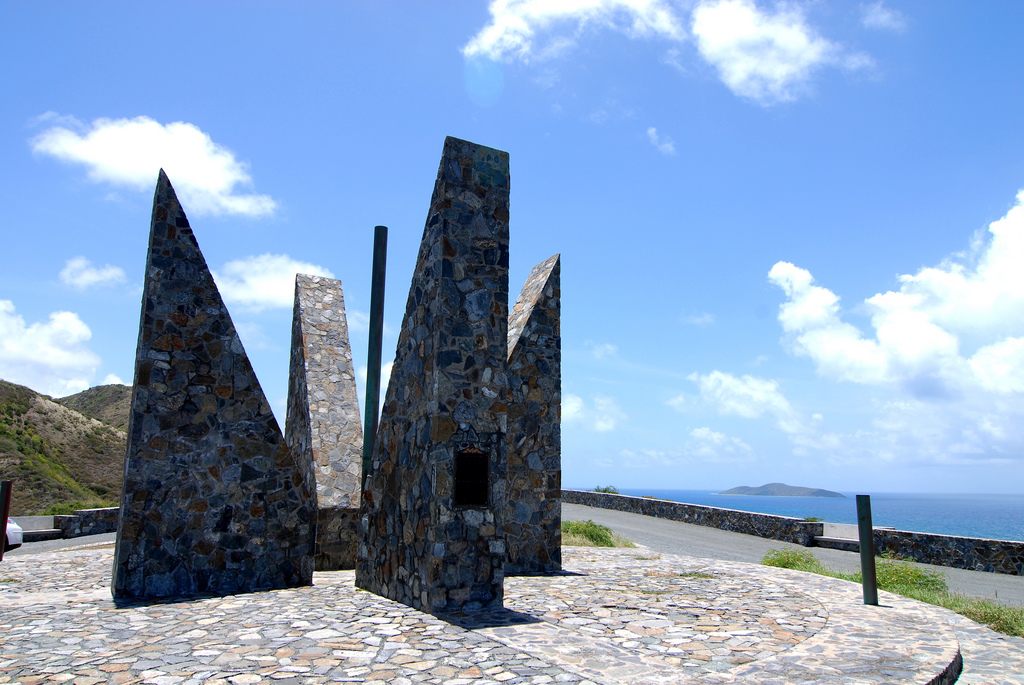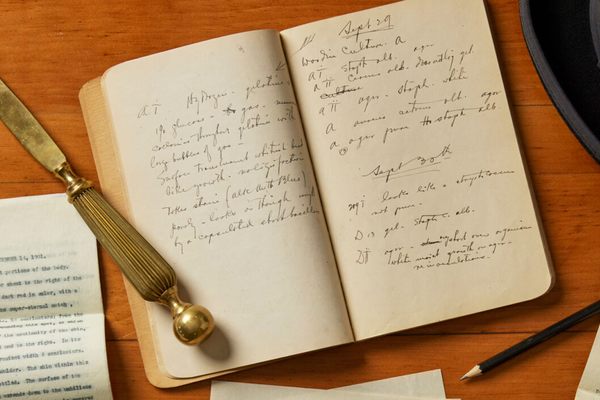A Hamilton Superfan’s Tour of the World
Trace the founding father’s footsteps around the globe with our 10-stop trip.
Trinity Churchyard in New York, where Alexander Hamilton is buried. (Photo: Yale University/Public Domain)
Alexander Hamilton is having a moment. The wildly popular Broadway depiction of the youngest and perhaps most inflammatory of the founding fathers plunged the populace into Hamilton fever. The musical (and the biography it was based on, written by historian Ron Chernow) paints an especially glowing picture of the man, but the ensuing fascination with Hamilton is not unwarranted; his achievements are impressive and many, and the story of his life is compellingly unique.
Unlike the wealthy aristocratic backgrounds of his contemporaries, Hamilton was an orphan, an immigrant, and a self-made man, who ascended the ranks of early American politics where else but in New York City.
While it’s been a year since Hamilton the musical opened on Broadway, the curiosity it inspired about the seminal politician endures. For the Hamilton superfans among us, here are 10 places around the world pulled from our Atlas to help feed that fascination.
The Ruins of Cottle Church
SAINT KITTS AND NEVIS


Cottle Church ruins. (Photo: Panoramio/Public Domain)
Young Hamilton’s unconventional path started out in the Caribbean. He was born out of wedlock in Charlestown, the capital city of the island of Nevis in the British West Indies. If your Hamilton world tour should take you to this tiny island, you may want to venture north of Charlestown to the ruins of Cottle Church. Hidden away in the woods, this tiny Anglican church was built by the former president of Nevis in 1824 as a place where his family and his slaves could worship together. The stone building provides a glimpse into the history of the humble island that produced one of the seminal leaders of the United States.
The Easternmost Point in the United States
CHRISTIANSTED, U.S. VIRGIN ISLANDS

Point Udall sundial. (Photo: tehusagent/CC BY-ND 2.0)
At a young age Hamilton’s family moved to the town of Christiansted on the island of St. Croix, where he worked as a clerk after his father abandoned the family. His mother passed away a few years later, leaving Hamilton orphaned by age 13 and itching to travel beyond the Caribbean. Interestingly, and perhaps appropriately, today Christiansted marks the easternmost point of United States territory. It’s known as Point Udall, and a stone sundial at the point marks the spot at which each day first begins in America.
The Oldest Fence in New York
NEW YORK, NEW YORK

The 1771 fence still stands in Bowling Green. (Photo: Luke J. Spencer)
Finally, we arrive in the States—or at the time Hamilton was around, the Thirteen Colonies. Noticed for being exceptionally bright, Hamilton was sent to study at King’s College in New York, which is now Columbia University. Tensions between England and the colonies were escalating, and in lower Manhattan a newly erected statue of King George III on Bowling Green was the focal point for anti-England protests. To protect the statue from the increasing threat of vandalism, a wrought iron fence was installed in 1771. Today it’s the oldest remaining fence in New York. The British plot didn’t work, however: the statue of the king was toppled in 1776 on the day the Declaration of Independence was read aloud for the first time, to Washington’s troops by City Hall. Hamilton’s time at college would be interrupted by the Revolutionary War.
The Tavern Where George Washington Bid His Troops Farewell
NEW YORK, NEW YORK

George Clinton room at Fraunces Tavern Museum. (Photo: Billy Hathorn/CC BY-SA 3.0)
During the war, General George Washington made the ambitious Hamilton his aide-de-camp and eventually permitted him to join the fight as a colonel, during which decisive battles were won under his command. Today a pocket of America’s fight for independence is preserved at Fraunces Tavern, a bar and historic museum on Wall Street in the neighborhood where Hamilton eventually lived. Once a popular haunt with Patriots, the tavern is best known for being the place where George Washington bid farewell to his officers at the end of the war. It also happens to be where Hamilton and his political rival Aaron Burr attended a dinner together just a week before their infamous duel in July 1804.
Philadelphia’s Last Wood-Paved Street
PHILADELPHIA, PENNSYLVANIA

Wood block pavement on South Camac Street. (Photo: Z22/CC BY-SA 4.0)
After the war was won came the hard part: building a country from scratch. Hamilton played a critical role. At Philadelphia’s Independence Hall he fought for a strong central government, and with Washington on his side was instrumental in getting the U.S. Constitution ratified.
Independence Hall is one of the most popular tourist spots in Philly, but just two miles north of the Hall and the First Bank of the United States (which Hamilton founded), you’ll find a very different relic of Philadelphia history: a small section of Camac Street that’s the last of the city’s wood-paved streets of the early 1800s.
Covering the streets with wooden blocks came about as an attempt to mask the loud noise of horse’s hooves clopping on cobblestones, but the wood blocks quickly began to soak up everything from rain to horse urine, and fell out of fashion. However on the tight little 200 block of Camac Street, the wooden avenues remained and, seen as a quaint oddity, were preserved.
Gold Vault at the Federal Reserve Bank
NEW YORK, NEW YORK

More gold than anywhere ever. (Photo: New York Federal Gold Vault/Public Domain)
As we all know, Hamilton was named the first Secretary of the Treasury by President Washington and proceeded to invent a system of public credit, establish the U.S. Mint, and create a national bank, a precursor to the Federal Reserve. (This after teaching himself to practice law, founding the Bank of New York, and restoring King’s College as Columbia University.)
Hamilton’s financial system went on to make America the wealthiest nation in the world, and his city the financial capital of the country. The moniker is true to this day, as a visit to the gold vault in the Federal Reserve Bank of New York will clearly show. In this vault in lower Manhattan just next to Trinity Church (where Hamilton is buried) is the world’s largest known depository of monetary gold.
Museum of American Finance
NEW YORK, NEW YORK

Main gallery at American Museum of Finance. (Photo: Markus Hartel/CC BY-SA 3.0)
Considering Hamilton’s financial achievements in Washington’s cabinet—achievements that would earn him a spot on the U.S. $10 bill—it’s appropriate that the founding father was the subject of the first major exhibit at the Museum of American Finance in downtown Manhattan.
Though it tends to be overshadowed by the Big Apple’s many famous museums, this ode to money, banking and the American free market is full of interesting and informative exhibits. It’s located on Wall Street a block away from the New York Stock Exchange that Hamilton’s early credit system would lead to, and housed in the the oldest bank in the United States, the Bank of New York, which Hamilton founded in 1784.
The Town Named After Angelica Schuyler
ANGELICA, NEW YORK

Park bench at Park Circle in Angelica, New York. (Photo: Park Stilfehler/CC BY-SA 1.0)
Any story of Alexander Hamilton would be incomplete without mentioning his wife Elizabeth Schuyler, whom he married in 1780 at the Schuyler Mansion in Albany and had eight children with. Or, for that matter, without mentioning her sister Angelica.
A witty, intelligent and charming woman, Angelica enchanted many influential leaders of the Revolution, including Thomas Jefferson, Ben Franklin and, not least, Hamilton himself, despite the fact he was happily married to her sister. The three were extremely close—so close that rumors persist Hamilton and Angelica’s love extended beyond friendship.
There is no evidence backing this up, but it’s clear the young founding father was quite smitten with his sister-in-law. Indeed, Angelica was so beloved by friends and family there is an entire town named after her: Angelica, New York. Today a quaint country town, it was settled in 1802 by Angelica’s son Philip Church, who named the village after his mother. For many years, the pistols from the famous duel where Hamilton was shot by Aaron Burr were kept in Angelica.
Weehawken Dueling Grounds
WEEHAWKEN, NEW JERSEY

Boulder where Hamilton may have rested while dying. (Photo: Theornamentalist/CC BY-SA 3.0)
Near the end of his time as Treasury Secretary, Hamilton’s luck started to run out. His ongoing marital affair became public, dealing a serious blow to his political career, to say nothing of his marriage. His oldest son died tragically in a duel defending his father’s honor. And tensions with his longtime rival Aaron Burr reached fever pitch when Hamilton supported Jefferson’s presidential bid over Burr’s.
Unable to reconcile, Burr and Hamilton scheduled a duel for July 11, 1804 in Weehawken, New Jersey. (Hamilton’s own son had been killed at the very same location, a bad omen Hamilton appears to have ignored.) Hamilton fired his gun into the air, and was shot. Burr fled the scene as his rival’s head was laid on a nearby boulder, which can still be found at the site alongside a monument.
Hamilton’s Grave at Trinity Churchyard
NEW YORK, NEW YORK

Alexander Hamilton grave. (Photo: Allison Meier)
The founding father was buried in the graveyard at Trinity Church, and today you are likely to still find flowers beneath the monument marking his gravestone—and a notable uptick of visitors since the hit musical debuted.
Now dwarfed by the surrounding Wall Street skyscrapers, Trinity Church was once the tallest building in New York City and the churchyard has graves dating back to the 17th century. Many influential leaders are buried here, including John Jacob Astor, Horatio Gates, Edward Koch, and James Monroe.
Next to Hamilton’s monument is a modest marble slab where Eliza buried. Outliving her husband by five decades, Eliza died in 1854 at the age of 97, but not before founding the first private orphanage, advocating for the construction of the Washington Monument, and working for decades to restore her husband’s good name and preserve his political legacy.

















Follow us on Twitter to get the latest on the world's hidden wonders.
Like us on Facebook to get the latest on the world's hidden wonders.
Follow us on Twitter Like us on Facebook